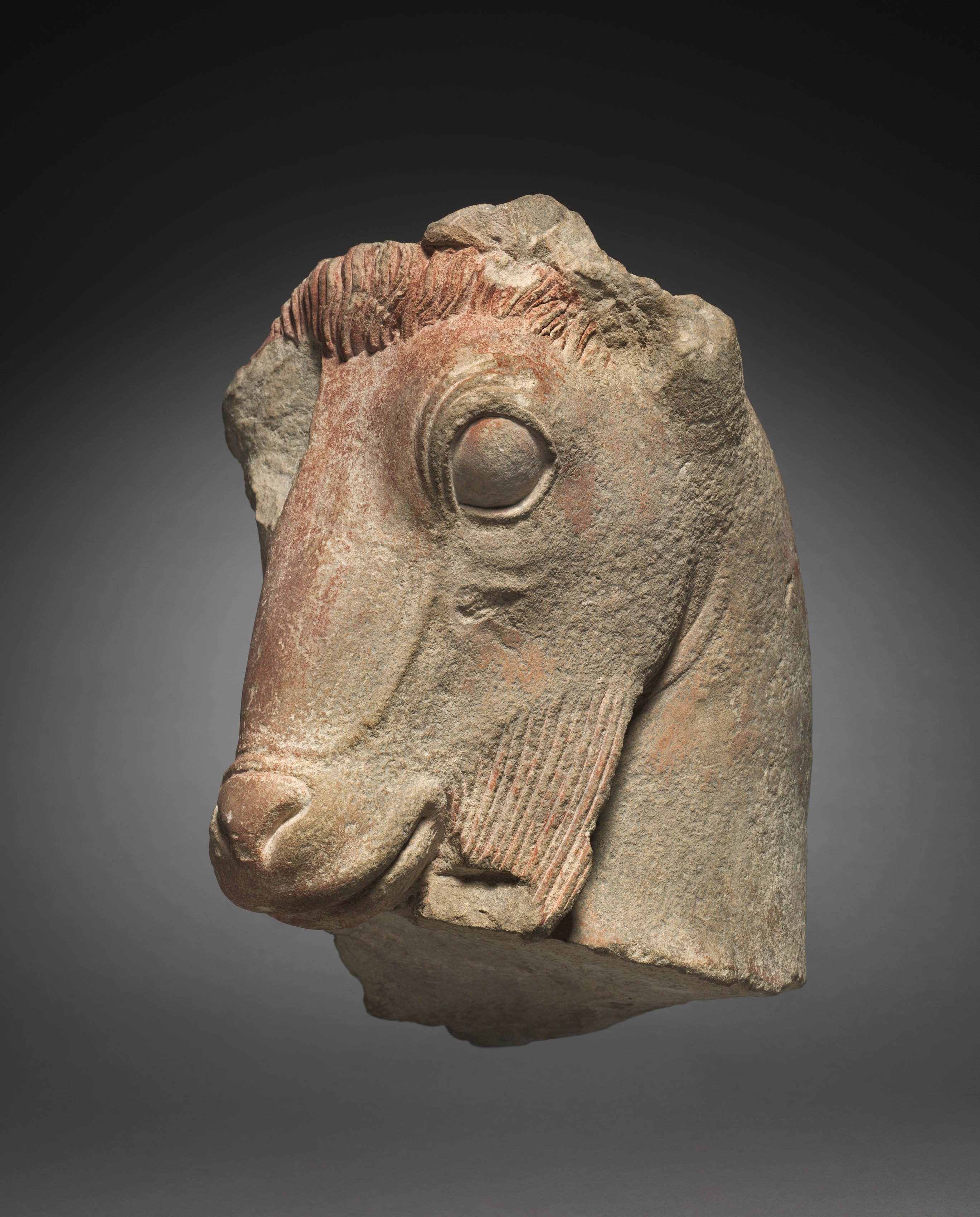The Cleveland Museum of Art
Collection Online as of April 20, 2024

Fragment of a Goat's Head
c. 500–475 BCE
Location: not on view
Did You Know?
Pan, the goat-headed god, is often called a son of Hermes, but sources disagree.Description
Initially identified as a horse head, this fragmentary sculpture, once painted reddish-brown, has a beard, indicating that it depicts a goat. Its large size, however, together with its neck position and unusual round eye, have all prompted questions. Was the head broken from a rearing goat? Or did it represent Pan, the rustic shepherd god often depicted as half-man, half-goat? If Pan, some scholars have connected it with a fifth-century BC Athenian sanctuary erected to thank the god for aid in battle. An alleged provenance near the Athenian Acropolis supported this idea, but scientific tests suggest otherwise.- 1926-1927Brummer Gallery, New York, NY, sold to the Cleveland Museum of Art1927-The Cleveland Museum of Art, Cleveland, OH
- The Brummer Gallery Records. Cloisters (Museum), n.d. A120 libmma.contentdm.oclc.orgHoward, Rossiter. "The Head of an Archaic Goat." The Bulletin of the Cleveland Museum of Art 14, no. 3 (1927). p. 36 www.jstor.orgInternational Studio (June 1927). p. 76The Cleveland Museum of Art. Handbook of the Cleveland Museum of Art. Cleveland, OH: The Cleveland Museum of Art, 1928. Reproduced: p. 74 archive.orgBieber, Margarete. "Greek Sculpture in the Cleveland Museum of Art," Art in America Vol. 31, No. 3 (July 1943). p. 113Cleveland Museum of Art. In Memoriam: Leonard C. Hanna, Jr. [Catalogue]. 1958. no. 222The Cleveland Museum of Art. Handbook of the Cleveland Museum of Art/1966. Cleveland, OH: The Cleveland Museum of Art, 1966. Reproduced: p. 20 archive.orgThe Cleveland Museum of Art. Handbook of the Cleveland Museum of Art/1969. Cleveland, OH: The Cleveland Museum of Art, 1969. Reproduced: p. 20 archive.orgRobinson, Henry S. "A Greek Head: Animal or Hybrid?" The Bulletin of the Cleveland Museum of Art 64, no. 7 (1977): 231-41. Illustrated on cover and Figs. 1-5. www.jstor.orgRidgway, Brunilde Sismondo. The Archaic Style in Greek Sculpture. Princeton University Press, 1977. Pp. 162, 180, Fig. 50.The Cleveland Museum of Art. Handbook of the Cleveland Museum of Art/1978. Cleveland, OH: The Cleveland Museum of Art, 1978. Reproduced: p. 24 archive.orgWalter, Hans. Pans Wiederkehr: der Gott der griechischen Wildnis. München: R. Piper, 1980. pp. 60-62, pls. 44-46Vermeule, Cornelius C. Greek and Roman Sculpture in America: Masterpieces in Public Collections in the United States and Canada. Malibu, Calif: The J. Paul Getty Museum, 1981. P. 36, No. 11.Kawami, Trudy S. "Greek Art and Persian Taste: Some Animal Sculptures from Persepolis." American Journal of Archaeology 90, no. 3 (1986): 259-67. Mentioned on p. 266, ill. pl. 16, fig. 10. www.jstor.orgN. Herz, A.P. Grimanis, H.S. Robinson, D.B. Wenner, and M. Vassilaki-Grimani. "Science versus Art History: The Cleveland Museum Head of Pan and the Miltiades Marathon Victory Monument," in Archaeometry 31.2 (1989): 161-168. doi.orgSekunda, Nick. Marathon 490 BC: The First Persian War. Oxford: Osprey, 2002. p. 84Neumann, Sabine. "Heiligtümer des Pan in Athen und Attika." Kolloquiumsband (2016)
- Stories From Storage. The Cleveland Museum of Art, Cleveland, OH (organizer) (February 7-May 16, 2021).The Silver Jubilee Exhibition. The Cleveland Museum of Art, Cleveland, OH (organizer) (June 23-September 28, 1941).
- {{cite web|title=Fragment of a Goat's Head|url=false|author=|year=c. 500–475 BCE|access-date=20 April 2024|publisher=Cleveland Museum of Art}}
Source URL:
https://www.clevelandart.org/art/1926.538